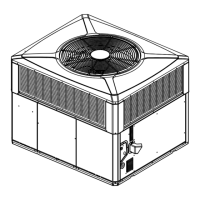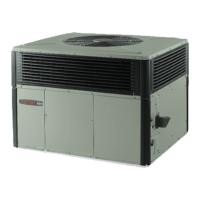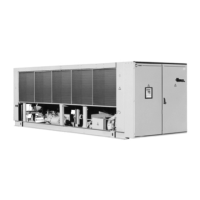26
18-EB41D1-1B-EN
operation remains the same as above. 2
nd
stage heat
has a 10 minute delay from the time of 1st stage
ignition.
TThheerrmmoossttaatt ssaattiissffiieedd::
(R) and (W1/W2) (jumped) contacts open signaling the
control module to close the gas valve and de-energize
the induced draft blower after approximately 5 second
postpurge. The indoor blower motor will continue to
operate at the current speed for 60 or 90 seconds after
the flames are extinguished.
SSaaffeettyy SSeeqquueenncceess
This product is equipped with safety devices to protect
against abnormal conditions.
The temperature limit switch (TCO) is located on the
blower barrier, and can be accessed through the
blower compartment. This automatic reset device
protects against excessive supply air temperature. If
this device opens, the gas valve is immediately closed
and will not permit operation until the limit switch
closes.
The rollout switch (RO) is located in the gas
compartment near the inlet of the burners. This is a
manual reset device designed to protect against any
form of flame rollout. If this device is opened the gas
valve is immediately de-energized and the control
(IGN) will lockout the system. The rollout switch (RO)
must be reset before operation is allowed to continue.
The pressure switch (PS) is located in the upper right
side of the gas compartment. This automatic device
assures adequate combustion air pressure. If pressure
against the induced draft blower outlet becomes
excessive, the pressure switch will react and shut off
the gas valve, until acceptable combustion pressure is
again available.
If the control (IGN) does not sense flame within the first
trial for ignition period, the gas valve will be de-
energized. The control (IGN) will initiate a 60-second
interpurge. Following the interpurge, the control will
perform a second ignition attempt. If the second try is
not successful, the control will start another 60-second
interpurge. After the interpurge, a third attempt will be
tried. If the third try is not successful, the control will
lock out.
If loss of flame occurs during a heating cycle, the
control (IGN) will close the gas valve and cycle through
the ignition trial as stated above.
If control lock out occurs, the control (IGN) will retry a
complete ignition sequence in 1 hour.
The control (IGN) can be reset by removing power to
the unit or by turning the thermostat from ON to OFF
for approximately three seconds, then back ON.
Cooling Cycle
TThheerrmmoossttaatt ccaallll ffoorr ccoooolliinngg ((22--ssttaaggee tthheerrmmoossttaatt))
CCaallll ffoorr 11
sstt
ssttaaggee ccoooolliinngg oonnllyy::
With the room thermostat set to the CCOOOOLL position and
the fan switch in the AAUUTTOO position, a call for cooling
will supply power to the unit from the room thermostat
(Y1) and (G) terminal. (Y1) provides power to the
compressor contactor (CC). The energized compressor
contactor (CC) completes the circuit to the compressor
for 1st stage (Low) operation and the outdoor single
speed fan motor (ODM). (G) provides power to the
(ECMC) for low speed (IDM) indoor fan motor
operation.
The thermostat will continue to cycle the compressor
and fans to maintain the desired temperature.
CCaallll ffoorr 22
nndd
ssttaaggee aafftteerr 11
sstt
ssttaaggee
On a call for 2nd stage cooling, power is supplied from
the room thermostat (Y2) terminal to the compressor
rectifier (ACR) and the (ECMC). This energizes the
(ACR) switching the compressor to 2
nd
stage (High)
operation. With the compressor’s internal solenoid
energized, both unloading orifices are closed enabling
the compressor to pump at full rated capacity. The
(ECMC) is energized for indoor fan motor (ECM) high
speed fan operation. The room thermostat will
continue to cycle the system between 1
st
and 2
nd
stage
to maintain the desired temperature without any
cycling time delays in operation.
Final Installation Checklist
☐ Does the unit run and operate as described in the
section on "Sequence of Operation" in response to
the room thermostat?
☐ Are the condenser fan and indoor blower operating
correctly with proper rotation and without undue
noise?
☐ Is the compressor operating correctly and has the
system been checked with a charging chart?
☐ Has the voltage and running current been checked
to deter mine if it is within limits?
☐ Has the thermostat been checked for calibration
and the air discharge grilles adjusted to balance the
system?
☐ Has the ductwork been checked for air leaks and
condensation?
☐ Has the furnace manifold pressure been checked
and adjusted if necessary?
☐ Has the heating air temperature rise been checked?
☐ Has the unit been checked for tubing and sheet
metal rattles? Are there any other unusual noises to
be checked?
☐ Are all covers and panels in place and properly
fastened?
☐ Has the owner been instructed on the proper
operation and maintenance of the unit? Be sure to
leave this manual with the owner.
UUnniitt SSttaarrttuupp

